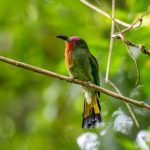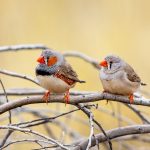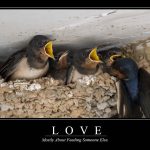Why would Swarovski Optik decide to completely revamp their classic EL line of binoculars? Birders all over the world can be forgiven for asking this question, as the original ELs are renowned for being a quality piece of glass. The reason, of course, is that the engineers and mad scientists squirreled away in Swarovski Optik’s secret mountain fortress thought they could do better. Could they? Well, read on and find out.
I have had a review pair of the new ELs around my neck since the end of May and I have used them on the rare occasion* when I have gone out birding. In fact, the only time I haven’t used the ELs is when I was letting someone else try them out, when I was using my old ELs for a comparison, or when I was using a pair of SLCs that will also be reviewed shortly. I must say straight out that I really, really, really like the new ELs and am thinking that I might try to pull a fast one and ship back a box full rocks to Swarovski and hope no one notices.
What is different about the new ELs? According to Swarovski’s propaganda one of the big differences are the “field-flattener lenses” which allow “contrast right up to the image edge.” What does that mean? Again, according to the publicity department at Swarovski Optik:
The field flattener lenses used produce a virtually flat image. As a result, even the finest structures and smallest details are reproduced with razor-sharp clarity right up to the image edge. For the first time ever, the observer obtains a perfect image with no annoying distortions. The outstanding image quality over the entire field of view means less refocusing and allows you to identify every detail at lightning speed.
I found Swarovski’s claims to be almost entirely true. Once I adjusted the twist-in eye-cups to the middle setting–I wear glasses and am used to having to screw eye-cups all the way in but for some reason (the better eye-relief?) I found that the image was better for me at the middle setting–the focus was sharp and the image was clear edge-to-edge without distortion. However, I was still unable to “identify every detail at lightning speed” though one can hardly blame the binoculars for that (trust me, I’ve tried). And while I do not have the experience with other high-end binoculars to make a truly informed comparison I will say that I don’t see how the image quality can be improved.
The close-focus ability of the new ELs has been much discussed in reviews. I’ll agree with Dominic Mitchell’s review from Birdwatch in which he says:
Another significant improvement is the close focus, which has reduced from 2.5 m to 1.5 m. This makes the new EL excellent for watching insects as well as birds, though the corollary of this is that it takes two full turns of the focusing wheel to get from the closest focus point to infinity. In practice this will rarely be an issue, however, as the first turn covers short-range viewing from 1.5-3 m, and the second turn everything from 3 m to infinity – that is, the vast majority of birding situations.
While, yes, the close focus capability means that to get through the entire range of binocular’s focus one must turn the focus wheel twice, this is not really a problem.
Having used my old ELs for quite some time it did take me awhile to get used to the slightly less bulky new ELs. They are as comfortable as ever to hold with an ergonomic design that should be the envy of anyone making consumer products so the adjustment didn’t take too long. The well-placed thumb indentations on the bottom of the barrels make the binoculars feel like they are built for your hands, which, of course, they are, but one wishes that other optic companies would understand that. The texture of the rubber armor coating is amazing as well, which, I must say, is not something I ever anticipated typing. The neck strap that comes with the binoculars is as comfortable as always, and the lens covers are easy to use and difficult to lose, a good combination. These binoculars are made to be enjoyed over the long haul, and the several** times I spent the entire day birding with them they never felt anything but comfortable.
Would I buy a pair of the new ELs? I would love to, but, unfortunately, such a purchase is out of my reach budget-wise right now. They are a great pair of binoculars and worthwhile investment if you are looking for high-end glass to use for the rest of your life. Think about it, if you are thirty now and plan to bird until you are eighty then spending about 2,300 USD is only 46 USD per year, or less 1 USD per week, a steal considering the quality of the optics you will have! The limited lifetime warranty that comes with the binoculars really does make them an investment and I am sure that if you purchase these binoculars you will be very, very, very, happy with how things look through them.
…
*By rare occasion I mean as often as possible, usually three or four times a week.
**Many













I know the EL Swarovisions are excellent bins, but my feeling is that thumb indents/grooves are a love/hate proposition. I have never liked them as they never fail to interfere with me getting the exact grip I want. They force your thumbs into a certain position to be comfortable. That said, a lot of people seem to like them, so… to each their own. Just my 2 cents.
Hard to get the focus exact almost looks like two images . Not enough depth of field. And to shaky.